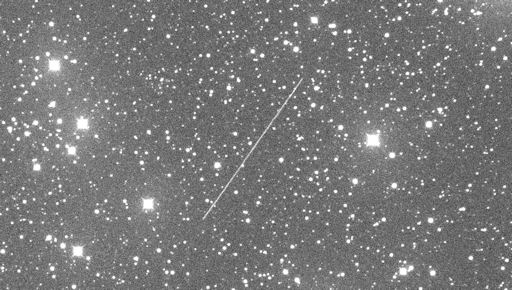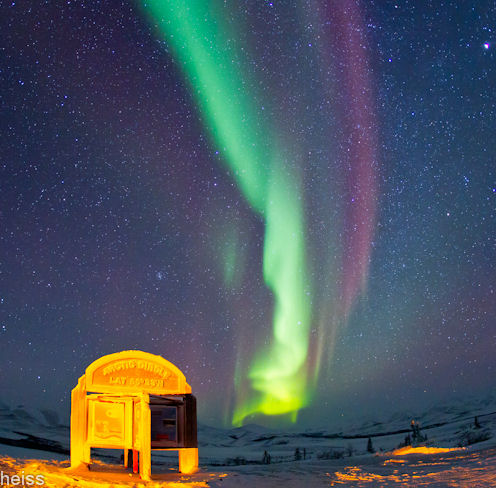GEMINID METEOR SHOWER--THIS WEEK! The annual Geminid Meteor Shower is set to peak on Dec. 13 and 14, 2012. The display, which is caused by an unusual 'rock comet,' could produce more than 100 meteors per hour during the dark hours before dawn this Thursday and Friday. [video] [meteor radar]
ASTEROID FLYBY: Newly-discovered asteroid 2012 XE54 is flying through the Earth-Moon system today approximately 230 thousand km (0.6 LD) from Earth. The space rock is about 36 meters wide, a little smaller than the Tunguska impactor that leveled 800 square miles of Siberian forest in 1908. Using a remote-controlled telescope in New Mexico, astronomers Ernesto Guido and Nick Howes photographed 2012 XE54 streaking among the stars on Dec. 11th:

Guido and Howes dedicate this image to the memory of their longtime friend and colleague Giovanni Sostero.
This asteroid will not hit Earth, but it is close enough, and thus bright enough, for amateur astronomers to track using backyard telescopes. When Guido and Howes photographed it this morning, it was shining at magnitude +13.
Astronomers monitoring the asteroid might have noticed an unusual eclipse during the early hours of Dec. 11th. According to calculations made by P. Tricarico, 2012 XE54 "will likely cross the Earth's shadow, causing a partial eclipse of the asteroid a few hours before reaching its minimum distance with the Earth. Asteroids eclipsing during an Earth flyby are relatively rare, with the first known case of asteroid 2008 TC3 which was totally eclipsed just one hour before entering Earth's atmosphere over Sudan in 2008, and asteroid 2012 KT42 experiencing both an eclipse and a transit during the same Earth flyby in 2012."
Stay tuned for updates.
ARCTIC LIGHTS: There was no geomagnetic storm last night, but around the Arctic Circle a geomagnetic storm is not required to produce auroras. Last night, photographer Mike Theiss was traveling along the Dempster Highway just north of Eagle Plains, Canada, when the sky erupted in color. The sign in the foreground marks the latitude of the Arctic Circle:
"It was insane," he says. "Lights danced all over the sky for 3 hours! I've never seen anything like it."
Theiss was located beneath Earth's auroral oval, a doughnut of light circling the North Pole where auroras sputter on and off even when geomagnetic storms are at low ebb. Displays like this could occur on any night of northern winter. Such auroras are all we can expect for the next few days as NOAA forecasters estimate a mere 5% chance of geomagnetic storms. Aurora alerts: text, voice.

![]()
Solar wind
speed: 294.4 km/sec
density: 4.7 protons/cm3
explanation | more data
Updated: Today at 2215 UT
![]()
X-ray Solar Flares
6-hr max: B3 1925 UT Dec11
24-hr: B5 1020 UT Dec11
explanation | more data
Updated: Today at: 2200 UT
![]()
![]()
![]()
Daily Sun: 11 Dec 12
![]()
![]()
None of the sunspots on the Earthside of the sun is actively flaring. Solar activity is low. Credit: SDO/HMI
![]()
![]()
![]()
Sunspot number: 49
What is the sunspot number?
Updated 11 Dec 2012
Spotless Days
Current Stretch: 0 days
2012 total: 0 days (0%)
2011 total: 2 days (<1%)
2010 total: 51 days (14%)
2009 total: 260 days (71%)
Since 2004: 821 days
Typical Solar Min: 486 days
Update 11 Dec 2012
The Radio Sun
10.7 cm flux: 104 sfu
explanation | more data
Updated 11 Dec 2012
![]()
![]()
![]()
Current Auroral Oval:
![]()
Switch to: Europe, USA, New Zealand, Antarctica
Credit: NOAA/POES
![]()
![]()
![]()
Planetary K-index
Now: Kp= 1 quiet
24-hr max: Kp= 1 quiet
explanation | more data
![]()
Interplanetary Mag. Field
Btotal: 3.4 nT
Bz: 2.3 nT north
explanation | more data
Updated: Today at 2216 UT
![]()
![]()
![]()
Coronal Holes: 11 Dec 12
![]()
![]()
There are no large coronal holes on the Earthside of the sun. Credit: SDO/AIA.





